
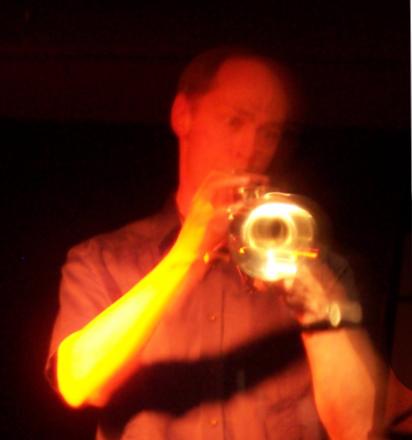
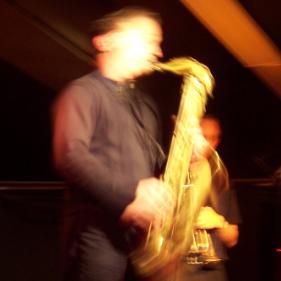

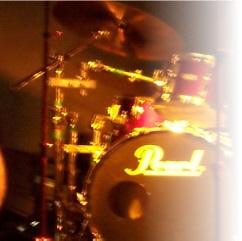
 |
|
Mole
Valley Music |
    |
Home | Teachers | Youth Music | Adult Music | Festivals | Grades | Buy, hire, repairs | Theory | Aural | Brass | Downloads | Philip Bishop - Brass Lessons | Double Bass | Acoustic Resonance | |
| Mole Valley Music - brass lessons: trumpet, cornet, etc. | |
Acoustic Resonance - jazz band playing jazz,
latin, blues, cocktail music, dancing for parties, weddings &
functions in Surrey, Sussex, Hampshire, London |
|
MoleValleyMusic.co.uk
Brass repairs
Past Trumpet and Cornet Sales
|
This page is devoted to advice for beginner brass pupils
and their parents. The advice and opinions are those of the author
(Philip Bishop). Sections are as follows: Getting
Started Music
books and Sheet Music About
Me
|
|
Valves |
Test each of the valves by moving it up and down rapidly. The valve should move very freely and "ping" back up. If a valve is sluggish or sticks down, ask the seller to oil the valve and check it again. If the valve still sticks, do not buy the instrument. |
|
Third valve slide |
The third valve (when you hold the instrument, that's the valve furthest from your nose) has a slide (piece of tubing) with a ring. This slide needs to be moved in and out very rapidly as the trumpet is played. Placing the ring finger or middle finger of your left hand in this ring and holding the third valve down, check the slide moves VERY freely. It should not take any effort to move it. If it doesn't, ask the seller to lubricate the slide. If it doesn't move easily, don't buy the instrument. |
|
Trombone slide |
The trombone's slide should move over the full range without ANY resistance. Make sure the slide is first lubricated (the seller should do this for you). Then check the slide moves freely by moving the slide backwards and forwards over a small range (10cm or 4 inches), gradually moving the slide further and further out, until you reach the point where the inner slide becomes slightly thicker (this is called the stocks). If you move the slide past the stocks and are not careful it will come off and there is a risk the slide might be damaged. If the slide has any areas of resistance and does not move freely, do not buy the instrument. |
|
Other slides |
Check all the other slides move. All instruments will have a tuning slide. Valved instruments such as trumpets and cornets will have a movable slide for each valve. These slides will be stiffer than the third valve slide, but should still move without being forced. Again, if they don't move, don't buy the instrument. |
|
Mouthpiece and case |
Check if the instrument comes with a mouthpiece and (preferable) hard case. Check the condition of these. The mouthpiece plating should be in good condition (playing on raw brass can lead to infections) and the mouthpiece should be free from dents. Also check the size of the mouthpiece and make sure it is suitable (consult an expert if in doubt). New cases and mouthpieces can be bought at relatively modest costs, but bear in mind any possible purchases when considering the price of the instrument. |
Starter instruments
Some of the better starter instruments are made by Yamaha. The following are recommended:
Trumpets: Yamaha YTR-2330.
Cornets: Yamaha YCR-2330.
Intermediate instruments
For those that have been playing for few years, the following are recommended:
Trumpets: Yamaha YTR-4335
Cornets: Yamaha YCR-4330G.
Anyone
with smaller hands who finds they can't reach the fixed 3rd valve
finger ring can have an adjustable finger ring fitted by e.g.
Will Spencer.
Just like used cars, trumpets and cornets are often much better value second hand. By hunting around you may be able to find good clean used instruments more much less than the price of a new one, or alternatively, you can buy a much better instrument for your money!
In addition to the above instuments, recommended older model Yamaha trumpets include YTR-2335 and for absolute beginners the YTR-1335.
Below are some good used instruments for sale, for different levels of player. If you would like to try out or buy one of these instruments, please contact Philip Bishop on 01372 454962 / 07950 235329.
| Trumpets, Cornets and French Horns for Sale |
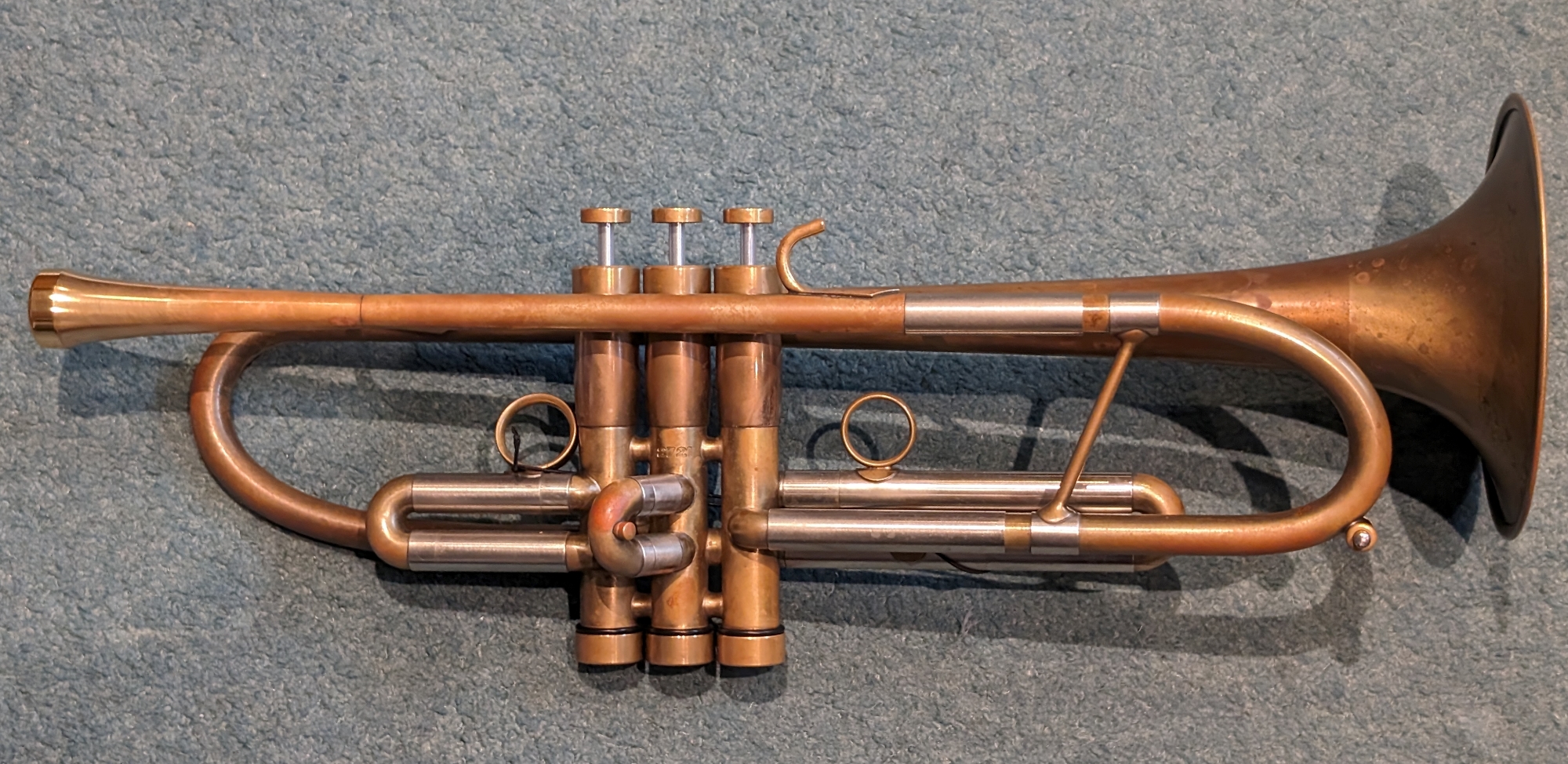
|
Those who have had lessons with me or with whom I have played will know I like to play rotary trumpets. Rotary trumpets are common in much of Europe, but in the UK are very rare, so they are scarce. If looking to buy, here are a few suggestions:
Second hand rotary trumpets:
try on ebay (both the UK www.ebay.co.uk
and the German www.ebay.de)
where bargains can be had (see Buying on
Ebay section)
Mid-range rotary B-flat trumpets:
try the B&S 3005/3
trumpet. This is available from Thomann (with a 30
day money back guarantee and a 3 year warranty) and should also be
available from Phil Parkers (the UK distributor for B&S -
telephone to check stock).
Top end rotary trumpets:
there are many makers of top end rotary trumpets including Thein,
Galileo
(both of which I play) and Schagerl.
For those that would like a rotary instrument that can be held like a normal piston trumpet, there are trumpet and flugel horns made by Schagerl, Schlub and Zirnbauer, amongst others. Here are a few pictures.
|
Schlub
trumpet
|
 Schargerl GanschHorn
|
|
 Schlub Flugel Horn |
If buying new, one of the better starter trombones to
buy is the Yamaha YSL-354. This trombone is a great
instrument for the beginner through to around grade 5.
For intermediate pupils, the Yamaha YSL-446GE or YSL-448GE are
excellent instruments. Both of these come with an F plug (or
valve), so that the 6th and 7th position notes can be played in 1st and
2nd position respectively: this saves a lot of shifting and, for the
shorter armed pupils, means the low B will be playable for the first
time!
Serious students should consider a Conn 88 or Bach 42, both of which come with the F valve (and also in versions without an F valve). These are large bore instruments which will develop a bigger, warmer more rounded sound. Suitable mouthpieces include Bach 4G and 3G - try before buying.
The normal rules when buying second hand apply! Also see the comments above.
Sharon McCallum is a trombone specialist. She usually carries quite a lot of stock and can often obtain used instruments to order. She is also one of the best trombone slide repairers in the business.
Also worth a try is Phil Parkers, 106a Crawford Street, London W1H 2HZ, 0207 486 8206. Ring before visiting to check what is available.
When buying, make sure all valves and slides operate freely (see comments above for trumpet and trombones).
Horns are available tuned in F and/or B-flat. B-flat horns are easier to play (particularly in the higher register) but can't produce the bottom notes. Most people spend 99% of the time playing B-flat, but if you have to play the lower horn parts in orchestras then you need the F.
Generally, pupils start on a single horn (usually single B-flat, preferably with stopping valve) and will later switch to a double horn.
Kindergarten French Horns: These are the smallest single horns, only suitable for the very young (primary school age). Look for a good second hand model, as new models will loose much of their value, and a larger horn will be needed as soon as the student can hold it.
Single B-flat French Horns: Often,
with an additional valve or two to change key (e.g. from B-flat to A,
low F extension). The A-valve is used for stopping (otherewise the
notes are out of tune), but can also be used to provide alternative
fingering for out-of-tune notes and the A-tube could be swapped with an
F-extension tube to help get some of the lower notes. The instruments
are lighter and more comfortable to play than double horns and some
musicians are happy to play a single horn all their life!
Single F
Horns: Only for those who have learned to play these horns
and are happy playing on an F horn! Vienna horns (which I
play) also fall into this category.
Double French Horns: These play in both F and B-flat and have a valve to switch between the two. They come is two forms: compensating horns and full double horns. Full double horns play better in tune but have more tubing and are heavier than the compensating horns. For more details, see the HornPlanet website. Double horns are usually introduced to pupils around grade 5 and are heavier and more expensive than single horns; they are, however, the standard horn that virtually everyone plays.
French horns are best bought from a french horn specialist. I recommend buying second hand as they are very expensive to buy new and will loose about half their value when sold. Expect to pay £400-£500 for a basic second-hand single horn, more for a double. Yamaha and Holton both make good intermediate instruments.
Contact the horn specialists to check what is available and what they recommend. Instruments are often bought by post (unseen), but check return conditions and guarantees before doing so.
Here are the names of a few french horn specialists:
Halstead Music, run by Tony Halstead, 07432 141410
Woodhead Horns, run by Luke Woodhead, 07970 971520
Paxmans, 020 7620 2077
Young (smaller) aspiring tuba players can start off with an E-flat compact tuba (on the right in the picture). These play the same deep notes as the larger tubas, although not with the same tone, but are much smaller and easier to hold and carry - about the same size as a baritone horn or euphonium.
Although most players start off and many continue with
an E-flat tuba (in the UK) there are other types. C tubas are
often played in orchestras. B-flat tubas are the largest, play the
deepest notes and have the advantage of the same fingering as the
euphonium and baritone horn.
Compact tubas are full size tubas are available at relatively modest prices from Wessex Tubas.
B-flat, E-flat and
compact tubas, from left to right
Practice mutes are designed to reduce the volume of sound to a minimum, whilst still keeping the playing feeling as close as possible to the un-muted feel (as open as possible). If you need to practice regularly with a practice mute, make sure you buy a good one; if you don't, you may find that your playing (particularly attacks, etc) may be worse after using one.
 One of the best (and the
practice
mute I use) is the Trumcor Lyric Stealth available from the Trumcor online shop.
These mutes are available for all brass instruments.
One of the best (and the
practice
mute I use) is the Trumcor Lyric Stealth available from the Trumcor online shop.
These mutes are available for all brass instruments.
Note that the Dennis Wick black practice mute is NOT suitable for prolonged practice. It is designed to be played for short periods each day to build up strength, and should be incorporated with other un-muted practice.
All the other mutes are designed to change the 'tone colour'. Mutes are only generally needed when you start to play in bands and orchestras. I suggest that you only buy mutes as and when you need them, starting with the straight mute and the cup mute.
All mutes are relatively cheap, so its worth buying good ones, which will probably last a life time. Good mutes play in tune and have a good sound. Whilst there are many good (and bad) mutes around, here are the ones I use or recommend. They can be bought at the specialist brass shops or on the web. In particular, the left-hand column shows the standard mutes that most players use (with the except of practice mutes, for which there is no standard).
| Straight Mutes |
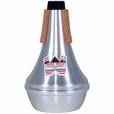 Dennis Wick straight mute The first mute to buy and the standard straight mute |
|
| Cup Mutes |
|
|
|
| Harmon Mutes |
 Jo-Ral Copper Bubble Mute A great mute, widely used, expensive but worth it (also in aluminium for a brighter sound) |
|
| Plunger Mutes |
|
Designed to work with the Humes & Berg Pixie Straight Mute |
 Humes & Berg Stone Lined Glenn Miller Plunger Mute |
| Bucket Mutes |
|
The standard bucket, giving a great sound, but fiddly to use; I used one for many years before switching to the Peter Gane version |
|
| Practice Mutes |
|
|
|
Plunger mutes: also try a sink plunger (from your local hardware shop) or a half coconut shell.
Music stands fall into two broad categories:

 Collapsible
wire stands
Collapsible
wire standsThese fold up and are easy to carry to rehearsals and
concerts. They are less stable and can't usually support large books.
Every musician has one of these! They can be obtained from virtually any music shop. Many
colours are available, but black is preferred for performing with. Buy
the most robust one you can find. Practise putting it up and down
(there is a knack - don't force it otherwise the metal will bend).

This is my favourite portable music stand. In use it is
very stable and handles the large orchestral music much better than the
foling wire stands. It had a shelf for bows and pencils, etc. It will
support heavy books. The feet stay out of the way of my double bass
spike and it adjusts from high to low. Its also quick to put up and
down, and light to cary in its shoulder bag.
One of these lives in the boot of my car!
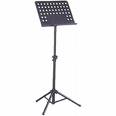 Sturdy
metal music stands
Sturdy
metal music standsThese are much sturdier and able to take large heavy
books. Some do collapse to some extent and they are generally preferred
to the collapsible type for playing from. When buying look for quality:
the threads on the securing bolts can get stripped on some of the
cheaper stands.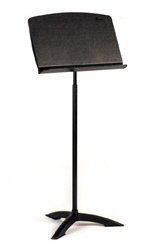
If you need a stand that needs to go up and down a lot, consider a Wenger Classic 50 music stand. Both my wife and I use the "Classic Stand 50" for home and teaching.
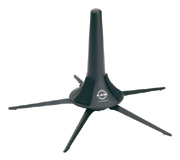 Most people
use the Konig & Meyer (K&M) stands.
Most people
use the Konig & Meyer (K&M) stands.
For trumpet, use the K&M 15213 trumpet stand. The 5-leg base provides maximum stability for the instrument. The detachable metal leg base screws into the peg so that the entire unit may be stored in the bell of the instrument for easy transport. The black plastic peg with felt pads to protect the instrument.
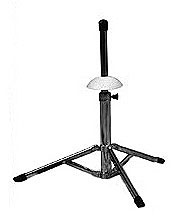 The
equivalent trombone stands are the K&M 14990
and K&M 14985.
The
equivalent trombone stands are the K&M 14990
and K&M 14985.
For trumpet, the main alternative is the Hamilton KB500 trumpet stand. The nickel plated compact KB500 folds to just 12 inches and is probably one of the highest quality stands around. The Hamilton is particularly good where you need to play standing up, or for home use, when you don't really want the trumpet bell at floor level.
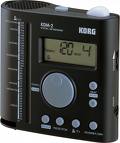 For
those with smart phones & tablets,
there are lots of metronome apps. My favourite Android app is
Metronome
Beats.
For
those with smart phones & tablets,
there are lots of metronome apps. My favourite Android app is
Metronome
Beats.
Of the physical metronomes, my favourite is the Korg KDM-2. It has a good sound, adjustable volume control, flashing light and easy to adjust speed control. In particular, it is loud enough to be easily heard when playing a trumpet, which many aren't. It runs on AAA batteries (as I use it a lot, I use rechargeable batteries).
There are a lot of other good metronomes on the market, and some which are not so suitable. When buying one, check you like the sound, check it is loud enough (take your instrument and play along with it), and make sure it doesn't use very expensive batteries.
These are used to check your tuning, both on individual notes and the instrument as a whole.
You can buy these devices, but I prefer to use an app on my phone, for which I've found Cleartune to be my favourite. It is available for both Android and Apple. It is really easy to use, and has a few advantages for brass players including:
(a) the ability to choose "Equal Temperament" (piano tuning) or "Standard Just Intonation" (which produces the in-tune sound, free of beats, used by brass groups, strings, etc)
(b) the ability to change the Tuning Root; so for example, you can set the Root to "D" so that the notes on a D trumpet appear as you would read them (so written C for Trumpet in D music appears as a C on the app).
You will need to buy the following types of cleaning brushes:
 Mouthpiece brush
Mouthpiece brushUse this bush to clean the mouthpiece. The mouthpiece should be cleaned every week using the brush and some warm water. The mouthpiece brush should live in the instrument's case, so that the mouthpiece can be cleaned at rehearsals and concerts if necessary.
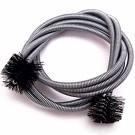 Flexible 'snake' brush and valve brush
Flexible 'snake' brush and valve brushThe snake brush is used to clean the inside of the instrument. It can be used on the lead pipe and tuning slide, etc, but NOT on the valves. More details are given in the section on washing the instrument.
The valve brush is used to clean the inside of the valve casing. Have a look at this excellent video to see how to use it.

If you need to protect your hearing, you will need some
musicians' earplugs.
Most earplugs cut the volume by different amounts at
different pitches, which makes a musical instrument sound rather
strange. Musicians' earplugs try to reduce the
volume by the same amount at all pitches, which makes the instrument
sound much better (although still not the same as without earplugs).
Here are a few options (including the ones I use):
Etymotic
ETY High Fidelity Earplugs
Custom fitted earplugs are also available which give
larger reduction of sound, choice of filters and better fit to the ear.
Finally, just to take the edge of the sound, I sometimes
use the Alpine earplugs without the filter. This reduces the
volume a little, but still keeps the sound natural.
Be aware the using earplugs for all playing will change
the sound you produce on your instrument!
Brass instruments require very little maintenance, but failure to do the few things that are needed will result in stuck slides, valves, etc, all of which make it hard to play the instrument and cost money to fix!
Here's what's needed for piston valved instruments (e.g. trumpets, cornets, etc.):
| Activity | How often |
| Wash the mouthpiece |
Once a week |
| Oil the valves |
Once a week, or as needed |
| Wash the instrument |
Once a month |
| Grease / oil the slides |
Once a month |
Here's what's needed for trombones:
| Activity | How often |
| Lubricate main slide |
Once a week, or as needed |
| Spray inner-tube of main slide with water |
Every day before playing and as needed |
| Wash the mouthpiece |
Once a week |
| Wash the instrument |
Once a month |
| Grease the tuning slide |
Once a month |
Click on the pictures or links below for a larger picture of the anatomy and part names.
Trumpet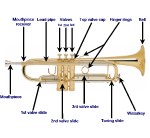 |
Cornet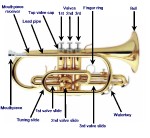 |
Trombone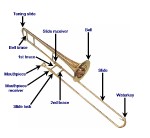 |
There are numerous valve oils available. Some are very good, some are so thick they make the valves go slower! Usually, oil which comes with beginner trumpets is too thick, so buy some better oil!
Here are the oils which I've found to work well on just about all trumpets and cornets.
|
|
|
|
|
|
Valve oil is normally kept in the instrument case, as it will be often needed.
IMPORTANT:
Most valve oils are poisonous. Read the instructions on the bottle.
If swallowed DO NOT induce vomiting. The fumes that are given off when vomiting occurs get into the lungs and it is these fumes which cause most damage.
Keep the top on oils, when not in use (to prevent the oil from oxidizing and leaking in the case).
Slide Grease is used on the 'Slow Slides'.
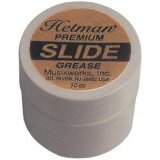 There
are a range of greases suitable for
trumpet and cornet slides on the market. My preferences are for Hetman
#7 Slide-Gel or BiNaK
Tuning Slide Lubricant. They both come in small tubs. If a
slide is on the loose side, use Hetman #7P Slide-Gel Plus
or even Hetman #9 Ultra Slide Grease.
There
are a range of greases suitable for
trumpet and cornet slides on the market. My preferences are for Hetman
#7 Slide-Gel or BiNaK
Tuning Slide Lubricant. They both come in small tubs. If a
slide is on the loose side, use Hetman #7P Slide-Gel Plus
or even Hetman #9 Ultra Slide Grease.
 Slide
oil is used on the 'Fast Slides'.
Slide
oil is used on the 'Fast Slides'.
This requires an oil that is thicker than valve oil, but not as thick as slide grease. My preference is for Hetman #5 slide oil. Order over the web.
Here's my preferred complete set of oils and greases needed to look after your trumpet or cornet:
Hetman #2
Valve Oil for the valves (#1 if you have close tolerance
valves)
Hetman #5 Slide Oil
for 1st and 3rd slides and water keys
Hetman #7 Slide-Gel
for tuning slide and 2nd slide
Hetman #10 Grease
for valve top and bottom caps
Hetman products are hard to find in the UK but. Outlets
include Thomann
and ebay.
Paxmans
in London also stocks some Hetman products.
For reference, here's the Hetman pdf guide
to lubricating your trumpet.
Here's my preferred complete set of oils and greases needed to look after your french horn:
Hetman #12
Rotor Oil for rotors, bearing, linkages and water keys
(#11 if you have close tolerance rotors)
Hetman #10 Grease
for the outer thread on rotor caps
Hetman #7 Slide-Gel
for slides
You could also use Hetman #13.5 Medium Bearing and Linkage oil instead of #12 on bearing and linkages (but not rotors).
Again, outlets include Thomann, ebay
and Paxmans.
For reference, here's the Hetman pdf lubrication guide.
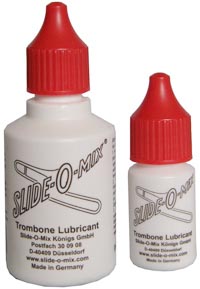
My preferred lubricant for main trombone slide is from Slide-O-Mix. Either the two part standard lubricant, or the all-in-one Rapid Comfort. Directions for use are given on the bottles.
In addition a trombone water spray bottle
will be needed. This should be kept topped up with water and the slide
misted with water before playing each day, and as necessary during
playing if the slide becomes stiff.
Both the slide lubricant and water sprayer should be
kept in the instrument case.
The tuning slide will also need to be lubricated with e.g. Hetman #7 Slide-Gel and if the trombone has a rotor it will need rotor, bearing and linkage oils as for the french horn e.g. Hetman #12 Rotor Oil.
The valves need regular oiling. Typically once a week, but sometimes more often if the valves become sluggish or stick down. Also immediately after the instrument is washed.
Since the valves may stick or become sluggish at any time, a bottle of valve oil (with top firmly on) and a lint free cloth (to wipe the valves clean) should be kept in the instrument case at all times.
Oil each valve individually, and replace it in the trumpet before oiling the next (to avoid mixing up the valves), as follows:
|
Step 1 |
Unscrew the cap of the valve oil and remove it. |
|
Step 2 |
Hold the instrument as shown. |
|
Step 3 |
|
|
Step 4 |
Remove the valve two-thirds of the way out, pulling it straight out without rotating it. Note which way round it comes out (look at the holes in the valve). |
|
Step 5 |
|
|
Step 6 |
Push the valve back down. |
|
Step 7 |
Gently rotate the valve slightly both ways until you here a click. The click is the valve guide (a small piece of plastic or metal located under the valve spring) snapping into the notch on the inside of the valve casing. At the point, the valve won't rotate any more and its holes will be aligned with slides. |
|
Step 8 |
Screw up the valve. |
|
Step 9 |
Repeat for the other valves. |
Always remove the valves one at a time. Always put the valve back before removing another valve.
Wash your hands after oiling the valves.
Note: removing the valve two-thirds of the way helps prevent reassembly problems and mixing up the valves. Once the basics are mastered, valves can be completely removed for wiping clean and re-oiling.
Tip for
Yamaha (and some other) trumpets: the valves are numbered
(1, 2 or 3) on the spring casing (just above where you oil the valves).
The number should face the mouthpiece end of the trumpet.
Here's
a link to an excellent video on cleaning and re-oiling your valves.
|
If sticking persists, remove valve and wipe with lint-free cloth, taking care to put it back in the right way round. |
|
|
If sticking still persists, then consult your teacher. If necessary a professional repairer can free up the valves, usually for a small fee. |
|
|
If the instrument won't play properly after you have oiled the valves, then either: (a) one of the valves is not aligned properly: you
will need to rotate that valve until it clicks in the slot; or |
Slides should be greased or oiled every time the instrument is washed and every month. If the slides are not lubricated the slides will become stuck and the instrument will need to be taken to a professional repairer.
Valved instruments have two types of slides:
Slow Slides: These are designed to be left in one position and moved infrequently. Slow slides include the tuning slide, 2nd valve slide and sometime the 1st and 3rd valve slide.
Fast Slides: These are used to fine tune individual notes and are designed to be moved rapidly in time for your playing. These slides are fitted with a finger ring or lever and may include the 3rd and 1st valve slides.
Slow slides are greased with a thick slide grease, as follows:
|
Step 1 |
Remove the slide (if removing a valve slide, press the corresponding valve down before removing the slide to avoid the vacuum 'popping'). |
|
Step 2 |
Wipe off any old grease with a lint-free cloth. |
|
Step 3 |
Using your finger, spread a thin smear of grease evenly over the slide. |
|
Step 4 |
Replace the slide (pressing the valve down first) and wipe off any excess grease that gets squeezed out. Note that more than a tiny amount of excess grease appears, you have put too much grease on the slide! |
|
Step 5 |
Repeat for all other slow slides. |
Slow slides are greased with a slide oil. The procedure is the same as for greasing the slides, but instead apply a few drops of slide oil and spread with a clean finger.
Wash your hands after greasing and oiling the slides.
There are many varied opinions about washing the inside of a brass instrument. Here's what I do and recommend.
|
Step 1 |
Run luke-warm water through the instrument for a couple of minutes. You can do this either by: (a) removing the shower-head from your shower and pointing the flexible nose down the trumpet and running warm water through the trumpet (being careful not to turn the tap on too hard if you have a pressurised water system) (b), if you can't do this, then filling a basin with water (with a splash of washing up liquid) and using a jug, repeatedly pouring it into the bell Whilst running the water through, hold the fast valve slides (to stop them coming out) and slowly and repeatedly move the first valve up and down, then the second valve and finally the third valve. Stop the water. |
|
Step 2 |
Remove the tuning slide. Push one end of the flexible snake brush into the mouthpiece receiver until to pops out the other end of the lead-pipe. Remove the brush. Push one end of the snake brush through the tuning slide. Remove the brush. Put the tuning slide back in. If cleaning a trombone, remove the main slide and repeat the procedure for the inside of both the inner and outer tubes of the main slide. When finished, re-assemble the main slide. |
|
Step 3 |
Remove the first valve, brush through each of the holes with a mouthpiece brush. Clean the inside of the valve casing with a valve cleaning brush. Put the valve back in (make sure it is the right way round - see instructions under oiling). Repeat for valves 2 and 3. At this point, you can also remove the valve slides and brush through the slides and the slide casing tubes. Reassmeble all slides so the trumpet is complete. |
|
Step 4 |
Run luke-warm water through the instrument for a couple of minutes, as for the first stage. |
|
Step 5 |
Insert a cleaned mouthpiece in the instrument and blow out any water, using the water keys where possible. Remove the slides which do not have water keys to help remove the water. |
|
Step 6
|
Carefully dry the outside of the instrument with a soft cloth. If any valve felts have got wet, dry those with the cloth. Put the trumpet aside to try for half a day or so. |
|
Step 7 |
Try not to get the felts wet (the felts are usually located above and below the top valve caps).
The mouthpiece may get stuck in the instrument if, for example, it is tapped in, or the instrument is dropped. If the mouthpiece is stuck, it can be removed with a mouthpiece puller. Ask your teacher if he/she has one (I carry one of these in my trumpet case - you can contact me here). Some music shops and most brass repairers will also have one.
Do not try and remove the stuck mouthpiece yourself. This will damage the metal and probably cause one or more of the joints to come apart!
The good news is that most dents can be removed and slides freed. Take your instrument to a professional repairer, such as one of those listed below. This doesn't usually cost much, and the result is usually almost as good as new (perfect repair requires refinishing the instrument, which is not usually cost effective).
Do not try and remove a dent or stuck slide yourself! This will almost certainly result in more damage to the instrument, making the repair that much harder and more expensive.
Recommended repairers:
Will
Spencer
Godalming
01252 706767
Roy Cox Brass Repairs
Kent
07765 050538
Manlio Mannisi
Ashtead
07840 069921
Phil
Parkers
106a Crawford Street, London W1H 2HZ
0207 486 8206
Dawkes Music
Maidenhead
01628 630800
Sharon
McCallum
Wales (particularly for difficult trombone slides)
01267 253374
For more information see the Brass
Specialists section.
Most pupils continue playing with braces, some even
taking exams.
The braces do have an impact on the playing, making it
uncomfortable and often loosing a note or two in range. There
are
ways to help alleviate the difficulties. Discuss this with
your
teacher.
Foxy
Dots Music publishes music "for those players just starting
to get good who have been clamped by the orthodontist." More
interesting music, but without the high notes.
|
English |
French |
Italian |
German |
|
Bb Piccolo Trumpet |
Petite Trompette en Sib |
Ottavino Tromba in Sib |
Kleine Trompete in B |
|
F Trumpet |
Trompette en Fa |
Tromba in Fa |
Trompete in F |
|
Eb Trumpet |
Trompette en Mib |
Tromba in Mib |
Trompete in Es |
|
D Trumpet |
Trompette in Re |
Tromba in Re |
Trompete in D |
|
C Trumpet |
Trompette in Ut |
Tromba in Do |
Trompete in C |
|
Bb Trumpet |
Trompette in Sib |
Tromba in Sib |
Trompete in B |
|
A Trumpet |
Trompette en La |
Tromba in La |
Trompete in A |
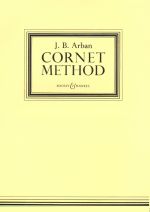 The
Cornet Method, by J. B. Arban (usually
called "The Arban" or the trumpet players bible), can be a little
daunting at first, particuarly the 14 studies near the back.
The
Cornet Method, by J. B. Arban (usually
called "The Arban" or the trumpet players bible), can be a little
daunting at first, particuarly the 14 studies near the back.
Top-Tip:
to get The Arban to open flat on the music stand, take your copy to a
printer and ask them to spiral
bind it. Even better, have it spiral bound in 2
or 3 different volumes (thanks to one of my pupils for this tip).
To help with the 14 studies,a separate books and CDs are
available (e.g. from
Just Music) with piano accompaniments for each study, edited
versions of the studies (to remove the errors), recordings of the piano
accompaniment at 3 different speeds, and a solo preformance of each of
the studies.
Available from Triplo
Press, the Arban Companion is a set of duet parts for the 14
Arban studies (catalogue number TRP-067). Have fun playing
Arban studies with your
friends!
The Arban is also available in bass clef for trombone and euphonium:
Arban Complete Method for Trombone & Euphonium, edited by Joseph Alessi and Brian Bowman.
Arban's famous Method for Trombone (available with and without accompanying CD for the solos) - also for use with euphonium.

For a little lights relief from the grades try:
100
Trumpet Solos - suitable for grade 5+
Philip Bishop teaches trumpet, cornet, flugelhorn, tenor horn, french horn, baritone, euphonium and trombone. Lessons are given privately, either in a music studio at my house in Bookham or in the schools in which I teach. For more information see the Philip Bishop Brass Lessons page.
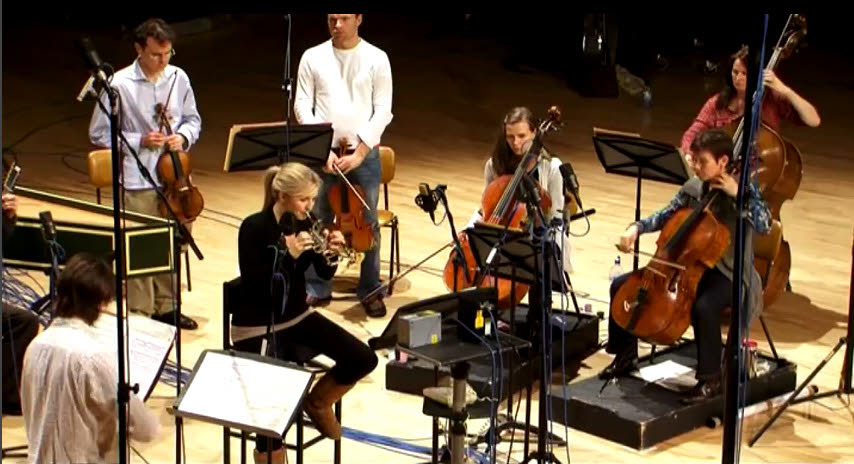
Listening and copying the great players are the first steps stage to developing a really good sound of your own. Listen for free on the web. Watch them on YouTube. Listen to recordings by other players and form your own list of favourite players... and support the musicians by buying their recordings.
Here are a few of my favourites.
Classical:
Maurice André
Hard to classify!
Rafael Mendez
Harry James
Jazz:
Clifford Brown
Miles Davis
Freddie Hubbard
French Horn:
Andrew Joy (also see the JoyKey water key)
Double Bass:
François Rabbath
Brass Groups:
| Top |
Copyright © 2006 Philip Bishop. All rights reserved.